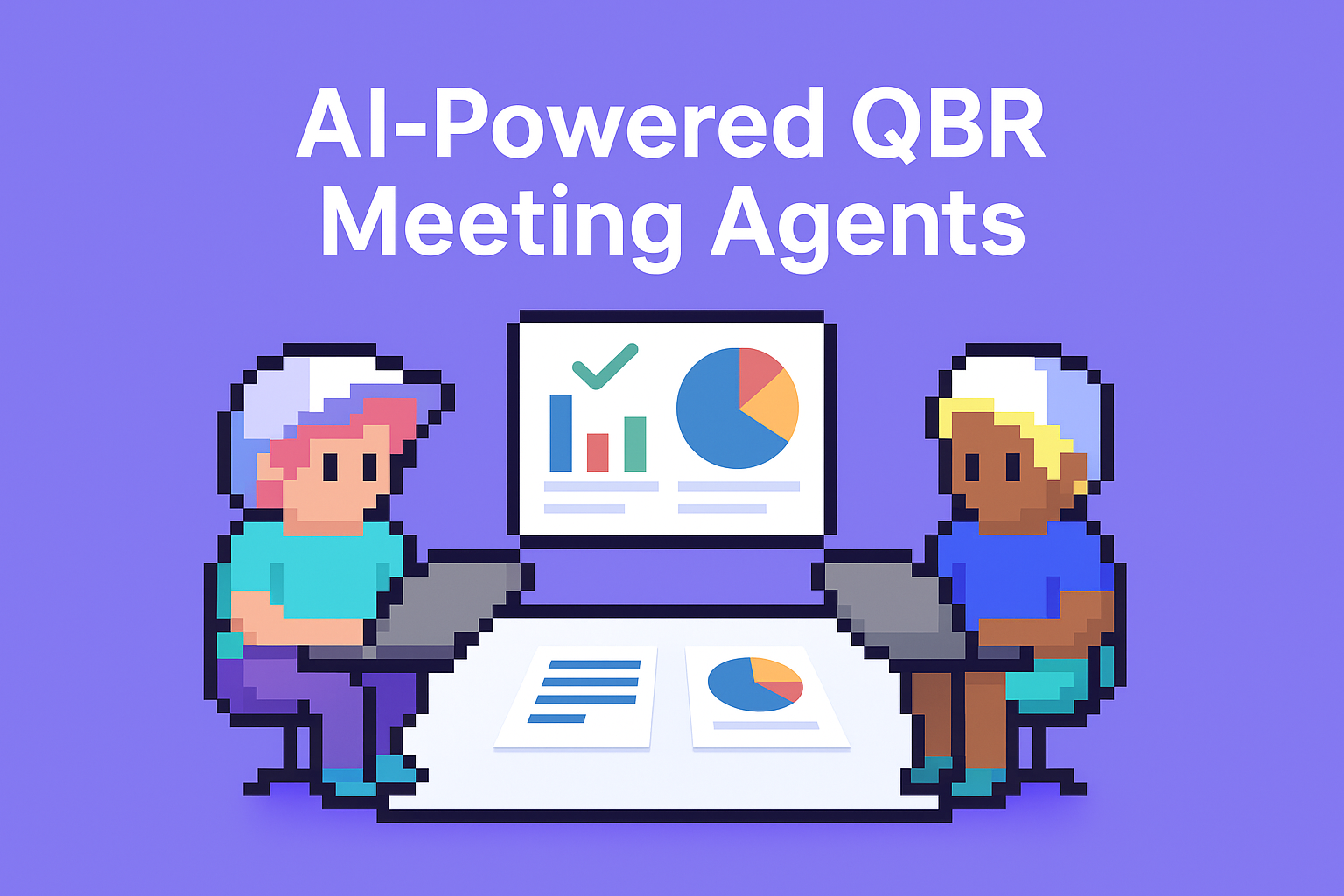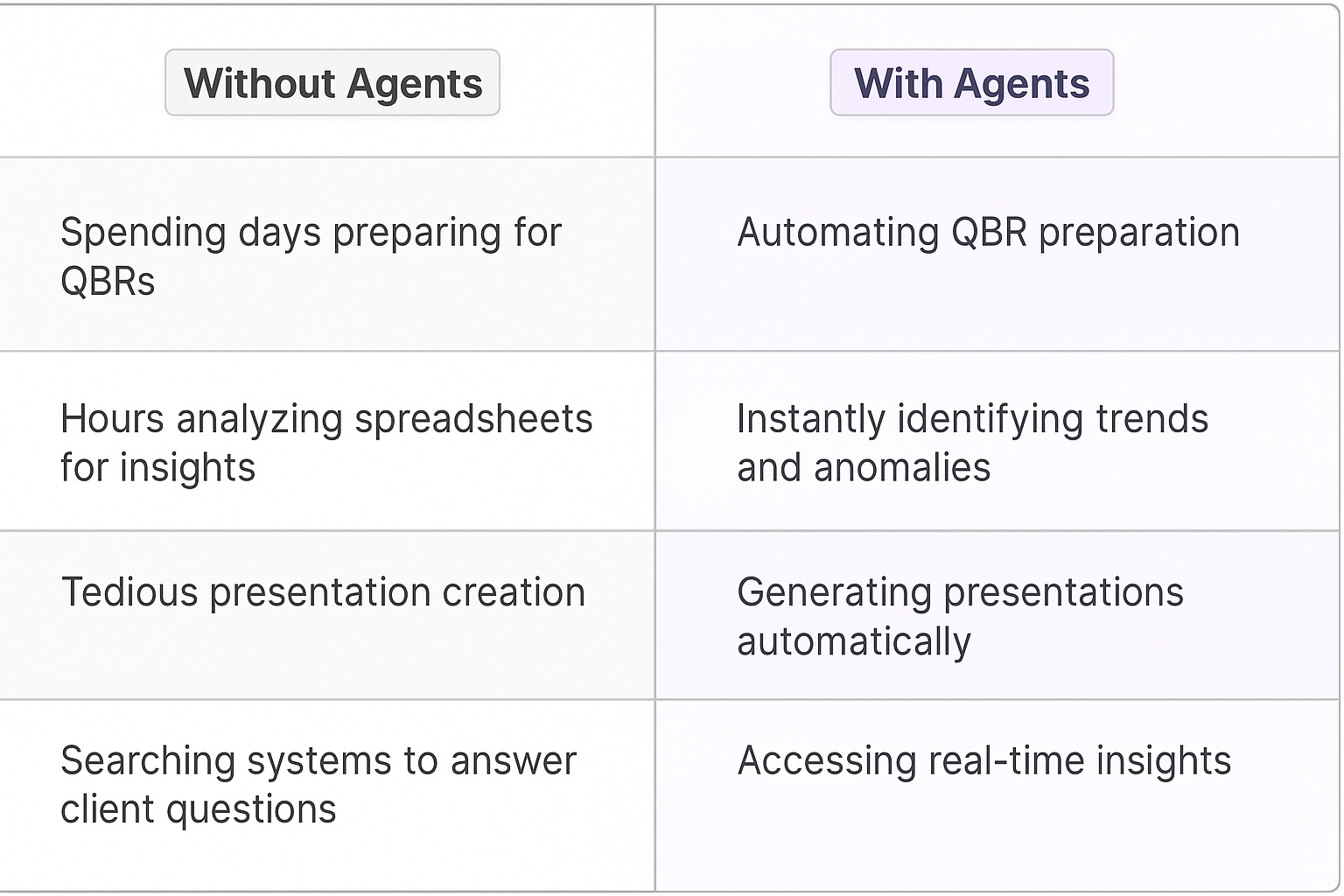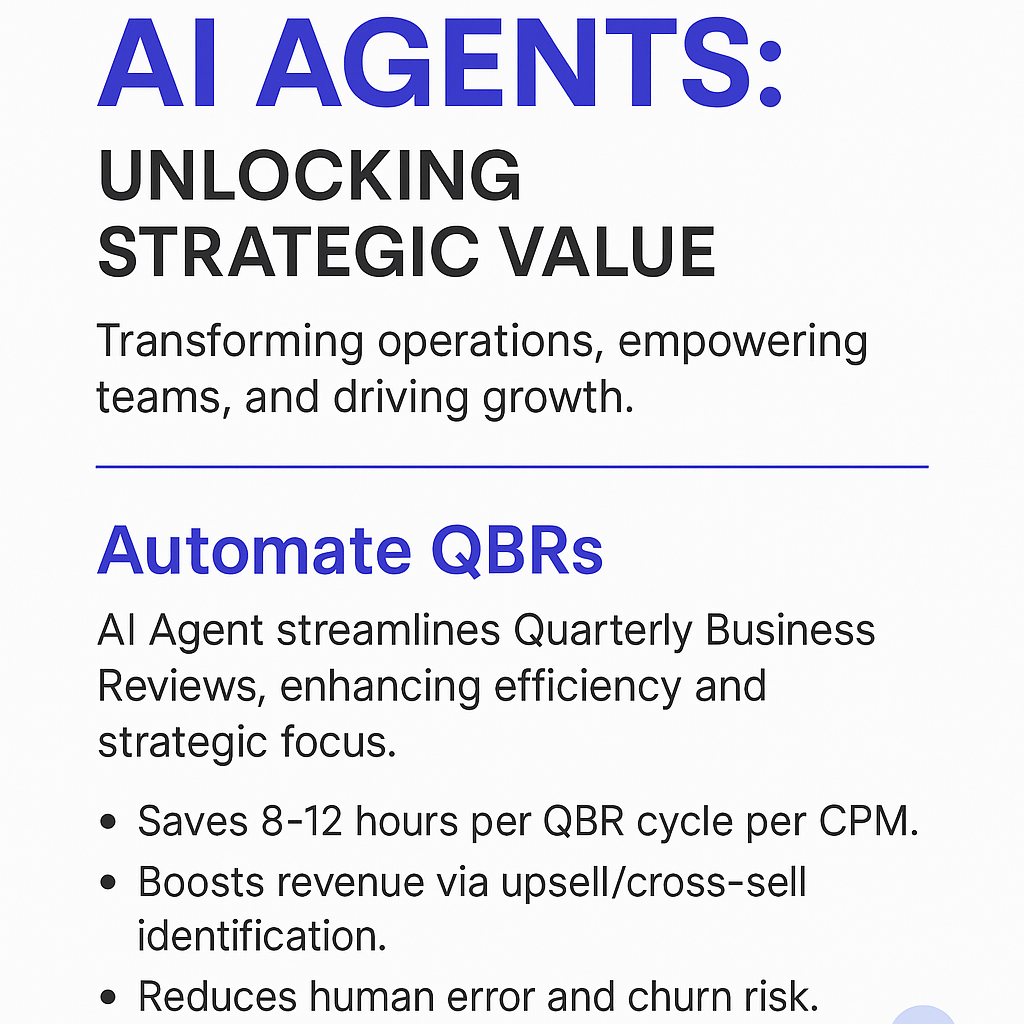
AI-powered QBR meeting agents are revolutionizing how Customer Portfolio Managers prepare for and conduct their quarterly business reviews. These agents automate data collection, identify key insights, and generate presentations, freeing up managers to focus on strategic discussions and relationship building. This technology streamlines workflows, improves communication, and enhances overall client satisfaction.
Before Meeting
Your AI agent gathers performance data from multiple sources, identifies key trends and anomalies, and generates an executive-ready presentation. You walk into the meeting with a clear, data-driven narrative.
During Meeting
As you discuss performance with the client, your AI agent provides real-time insights, answers questions, and identifies potential expansion opportunities. This keeps the meeting focused and productive.
After Meeting
Post-meeting, your AI agent generates a summary of key discussion points, action items, and follow-up tasks. This ensures that everyone stays aligned and accountable.
What you’ll need
You don't need to be a developer to set up this integration. Follow this simple guide to get started:
- Meeting Notetaker Agent template
- Calendar account
- Meetings to join
- Relevance AI Account

Who this agent is for
This agent is designed for Customer Portfolio Managers, Key Account Managers, Customer Success Managers, and anyone responsible for conducting Quarterly Business Reviews (QBRs) with clients. It's ideal for individuals and teams who manage a portfolio of accounts and need to demonstrate value, build relationships, and drive business growth. Whether you're a solo manager or part of a large customer success organization, this agent simplifies QBR preparation and ensures that you're always prepared to deliver a compelling and insightful presentation.
How this agent makes QBR planning easier
Automate data collection from multiple sources
Instead of manually gathering data from various systems, the agent automatically pulls information from CRM, marketing automation, product usage, and other relevant sources.
Identify key trends and anomalies
The agent analyzes the data to identify key trends, patterns, and anomalies that might not be immediately apparent. This helps you focus on the most important insights during the QBR.
Generate executive-ready presentations
The agent automatically creates visually appealing and informative presentations with key metrics, charts, and graphs. This saves you hours of manual slide creation.
Provide real-time insights during the meeting
During the QBR, the agent provides real-time insights and answers questions based on the latest data collection. This helps you address client concerns and identify new opportunities.
Benefits of AI Agents for Customer Portfolio Managers
What would have been used before AI Agents?
Customer Portfolio Managers traditionally relied on manual data collection, spreadsheet analysis, and slide creation to prepare for QBRs. This process was time-consuming, prone to errors, and often resulted in last-minute scrambles to gather the necessary information. They would spend countless hours compiling data, creating charts, and formatting presentations, taking away from their core responsibilities of relationship building and strategic planning.
What are the benefits of AI Agents?
AI agents offer a streamlined and automated approach to QBR preparation, freeing up Customer Portfolio Managers to focus on more strategic tasks. The most significant benefit is the time saved by automating data collection and presentation generation. The agent handles everything from pulling data from multiple sources to creating visually appealing slides, reducing the administrative burden on the manager.
AI agents also improve the accuracy and consistency of QBRs by ensuring that all data is up-to-date and presented in a standardized format. This helps build trust with clients and demonstrates a commitment to data-driven decision-making. Furthermore, the agent enhances communication by providing real-time insights and answering questions during the QBR, keeping the discussion focused and productive.
By integrating with existing CRM and other business systems, the agent provides a seamless and user-friendly experience. This eliminates the need for manual data entry and ensures that all QBR-related information is easily accessible. Ultimately, AI agents enhance productivity, reduce stress, and allow Customer Portfolio Managers to focus on building stronger client relationships and driving business growth.
Traditional vs Agentic meeting planning
Traditionally, Customer Portfolio Managers spent days preparing for QBRs, manually compiling data and creating presentations. Now, AI agents automate this, freeing up time for strategic discussions. Before, finding key insights required hours of spreadsheet analysis. With an agent, key trends and anomalies are identified instantly. Presentation creation used to be a tedious task. Now, executive-ready presentations are generated automatically. Finally, answering client questions during the QBR often required searching through multiple systems. The agent provides real-time insights, ensuring accurate and timely responses.

Tasks that can be completed by a QBR Meeting Planner Agent
Customer Portfolio Managers juggle numerous tasks, from managing client relationships to developing strategic plans and driving business growth. A QBR meeting planner agent can handle many of the administrative tasks associated with preparing for and conducting QBRs, allowing managers to focus on their core responsibilities.
Gathering Performance Data from Multiple Sources
The agent automatically pulls data from CRM, marketing automation, product usage, and other relevant sources.
Identifying Key Trends and Anomalies
The agent analyzes the data to identify key trends, patterns, and anomalies that might not be immediately apparent.
Generating Executive-Ready Presentations
The agent automatically creates visually appealing and informative presentations with key metrics, charts, and graphs.
Providing Real-Time Insights During the Meeting
During the QBR, the agent provides real-time insights and answers questions based on the latest data.
Tracking Action Items and Follow-Up Tasks
The agent automatically tracks action items and follow-up tasks discussed during the QBR and sends reminders to ensure that they are completed.
Generating Meeting Summaries and Reports
The agent automatically generates meeting summaries and reports that can be shared with clients and internal stakeholders.
Benchmarking Performance Against Industry Standards
The agent can benchmark client performance against industry standards to identify areas for improvement.
Identifying Expansion Opportunities
The agent can identify potential expansion opportunities based on client usage patterns and market trends.

Things to Keep in Mind When Building a QBR Meeting Planner Agent
Building an effective QBR meeting planner agent requires careful planning and attention to detail. The goal is to create an agent that seamlessly integrates with your existing workflows and provides a user-friendly experience for all participants.
Define Clear Objectives
Before you start building your agent, define clear objectives for what you want it to achieve. Do you want to reduce QBR preparation time, improve data accuracy, enhance client communication, or all of the above? Having clear objectives will help you prioritize features and measure success.
Integrate with Existing Systems
Ensure that your agent integrates seamlessly with your CRM, marketing automation, product usage, and other relevant systems. This will allow it to automatically gather the necessary data for QBR preparation.
Prioritize Data Security and Privacy
Protect client data by implementing robust security measures and adhering to privacy regulations. Ensure that the agent is compliant with GDPR, CCPA, and other relevant data privacy laws.
Automate Data Analysis and Reporting
Configure the agent to automatically analyze data and generate reports that highlight key trends, patterns, and anomalies. This will save you hours of manual data analysis and help you focus on the most important insights.
Provide Customizable Templates and Dashboards
Allow users to customize the agent's templates and dashboards to match their specific needs and preferences. This will make it easier for them to create visually appealing and informative presentations.
Test Thoroughly
Before you roll out the agent to your entire team, test it thoroughly to ensure that it is working correctly and that it meets your objectives. Gather feedback from users and make any necessary adjustments.
Continuously Improve
Once your agent is live, continue to monitor its performance and gather feedback from users. Use this information to identify areas for improvement and make ongoing enhancements.
The Future of AI Agents in Meeting Planning
The future of AI agents in QBR meeting planning is bright, with advancements in natural language processing, machine learning, and artificial intelligence promising to further streamline and enhance the QBR process. Future agents will be able to understand complex client requests, anticipate potential concerns, and proactively suggest solutions.
AI agents will also become more personalized, learning individual client preferences and tailoring their recommendations accordingly. They will be able to identify preferred communication styles, preferred presentation formats, and even preferred topics of discussion, creating a more seamless and user-friendly experience.
Furthermore, AI agents will play a larger role in facilitating collaboration and communication during QBRs. They will be able to transcribe meeting minutes, track action items, and even provide real-time translation services, making QBRs more productive and inclusive.
AI agents will also integrate with other business applications, such as project management tools and CRM systems, providing a holistic view of client-related activities and enabling better decision-making.
Ultimately, the future of AI agents in QBR meeting planning is about creating intelligent systems that not only automate the QBR process but also enhance client relationships, improve communication, and drive better business outcomes.









